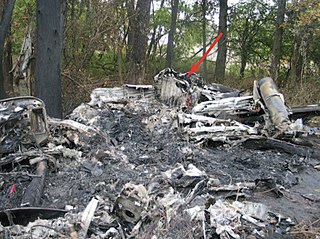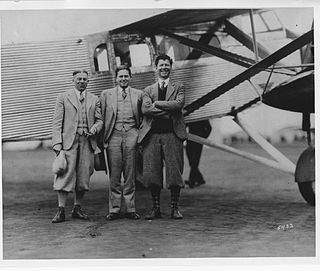
Elm Farm Ollie (also known as "Nellie Jay" [1] ) became the first cow to fly in an airplane on February 18, 1930, as part of the International Aircraft Exposition in St. Louis, Missouri, United States. [2]

Elm Farm Ollie (also known as "Nellie Jay" [1] ) became the first cow to fly in an airplane on February 18, 1930, as part of the International Aircraft Exposition in St. Louis, Missouri, United States. [2]
The newly-built St. Louis Arena served as the location for the second International Aircraft Exposition. [3] Organized by the Aeronautical Chamber of Commerce, the expo aimed to reinvigorate the floundering aviation industry. The onset of the Great Depression in the United States greatly diminished the market for planes, while supply of aircraft remained high, as did the public's concerns about the flight safety. [4] Simultaneously, the industry grappled with internal struggles related to U.S. government air mail contracts which they felt threatened their financial stability. [5] [6] Famous aviators including Edward Stinson and Elinor Smith took part in the expo to help draw crowds. [7] Charles Lindbergh, renowned pilot of the Spirit of St. Louis, was announced as an attendee. [8] Event organizers promised public displays of planes and other aviation exhibits valued at over $2,500,000, an aviation-themed musical, and aerial demonstrations, including several world-record and world-first flights. [9]
Up until the expo, no cow is known to have flown. In keeping with the motivations for the show, it was hoped that getting a cow airborne would generate buzz about planes, show the stability and safety of aircraft, and demonstrate the possibility of aviation as an effective means to transport livestock. Advertisements for the stunt also promised "scientific data will be collected on her behavior." [10] [2] Elm Farm Ollie, a Guernsey cow, was flown in a Ford Trimotor piloted by Claude Sterling of Parks Air College from her home at Sunnymeade Farms in Bismarck, Missouri to St. Louis. She was reportedly chosen because of her high daily milk yield, requiring up to three daily milkings. [1] She was milked by Elsworth Bunce, in the process also becoming the first cow milked in-flight. The yield was then put into containers attached to parachutes and tossed out of the aircraft as it flew over the onlookers in the city below. Some accounts state the milking occurred on the flight from Bismarck, [11] while others indicate it took place during a second flight that originated in St. Louis. [2] As Lindburgh was speculated to attend the exposition, some milk was reserved for him, though the speculation proved to be false and he never actually made it to St. Louis. [2] [12]
The story of Elm Farm Ollie turned up several times in trivia books and newspaper articles over the decades, including a feature in the Ripley's Believe It or Not! comic strip. [13] She has been enshrined in Wisconsin, the Dairy State, where Barry Levenson, a former state Assistant Attorney General and founder of the National Mustard Museum, made February 18 "Elm Farm Ollie Day" in connection to a festival in Mount Horeb, Wisconsin, the museum's former location. [14] [1] Levenson's contributions to the Elm Farm Ollie corpus include a cantata titled "Madamme Butterfat." [15]

The Robert J. Collier Trophy is awarded annually for the greatest achievement in aeronautics or astronautics in America, with respect to improving the performance, efficiency, and safety of air or space vehicles, the value of which has been thoroughly demonstrated by actual use during the preceding year.

The Spirit of St. Louis is the custom-built, single-engine, single-seat, high-wing monoplane that Charles Lindbergh flew on May 20–21, 1927, on the first solo nonstop transatlantic flight from Long Island, New York, to Paris, France, for which Lindbergh won the $25,000 Orteig Prize.
Lee Ulrich Eyerly was an American civil aviation pioneer and amusement ride manufacturer. Eyerly helped found Salem Oregon's McNary Field, built the Flying E Ranch in Wickenburg, Arizona and invented several amusement park rides including the Loop-O-Plane, the Roll-O-Plane the Fly-O-Plane the Rock-O-Plane, and the Octopus.

Corporate Airlines Flight 5966 was a scheduled passenger flight from St. Louis, Missouri to Kirksville, Missouri. On October 19, 2004, the Jetstream 32 aircraft operating the flight crashed on approach to Kirksville Regional Airport as a result of pilot error, killing 13 of the 15 people aboard.

FITS Aviation (Pvt) Limited, DBA FitsAir, is a Sri Lankan airline. It operates scheduled passenger services within Sri Lanka, as well as international cargo flights to several cities in the Middle East, Asia and Africa, and also operates charter flights to India. The company slogan is Friend In The Skies.FitsAir is a subsidiary of Aberdeen Holdings (Pvt) Ltd, a diversified conglomerate headquartered in Sri Lanka.

Kirksville Regional Airport is four miles south of Kirksville, Missouri, on the west side of US highway 63. One airline schedules passenger flights, subsidized by the Essential Air Service program.
Memorial Field Airport is located in City of Hot Springs, in Garland County, Arkansas, United States, 3 miles (4.8 km) southwest of Downtown Hot Springs. It serves nearby Hot Springs National Park. The airport is used for general aviation; airline flights are subsidized by the federal government's Essential Air Service program at a cost of $1,637,012.

Daytona Beach International Airport is a county-owned airport located three miles (5 km) southwest of Daytona Beach, next to Daytona International Speedway, in Volusia County, Florida, United States. The airport has 3 runways, a six-gate domestic terminal, and an international terminal. Daytona Beach is the headquarters of Embry-Riddle Aeronautical University.

Quincy Regional Airport is a city-owned airport 12 miles east of Quincy, a city in Adams County, Illinois, United States. It is used for general aviation but also sees Southern Airways Express flights to Chicago's O'Hare International Airport and St. Louis Lambert International Airport, a service which is subsidized by the federal government's Essential Air Service program at a cost of $1,956,856. The Federal Aviation Administration (FAA) National Plan of Integrated Airport Systems for 2023–2027 categorized it as a national non-primary commercial service facility.

Veterans Airport of Southern Illinois , also known as Williamson County Regional Airport, is five miles west of Marion, in Williamson County, Illinois, United States. The airport is owned by the Williamson County Airport Authority. It sees one airline, subsidized by the federal government's Essential Air Service program at an annual cost of $2,562,819 or $141 per passenger. On November 11, 2016 during the grand opening ceremony for the new terminal, the airport was renamed to "Veterans Airport of Southern Illinois" to honor veterans and better reflect the regional nature of the airport.

Wiggins Airways is a long-lived American aviation company that pursued many lines of business during its existence, including:

The 1955 Cincinnati mid-air collision occurred on January 12, 1955, when Trans World Airlines Flight 694 Martin 2-0-2 on takeoff from Boone County Airport collided in mid-air with a privately owned Douglas DC-3 that had entered the airport's control space without proper clearance. None of the occupants of either plane survived the collision.

The Metal Aircraft Flamingo was a monoplane produced in Cincinnati, Ohio by the Metal Aircraft Corporation in the 1930s.
Parks College of Engineering, Aviation and Technology was a college within Saint Louis University. It formed from the pre-existing Parks Air College, founded by Oliver Parks in 1927. Its successor is the Oliver L. Parks Department of Aviation Science within the SLU School of Science and Engineering at Saint Louis University.

Maryland's first aeronautical event was the flight of 13-year-old Edward Warren from Baltimore in Peter Carne's tethered hot air balloon in 1784.

George Henry Prudden, Jr. was an American aircraft engineer. He was instrumental in designing the first all metal aircraft in America. He was president of the Early Birds of Aviation in 1961.

Robertson Aircraft Corporation was a post-World War I American aviation service company based at the Lambert-St. Louis Flying Field near St. Louis, Missouri, that flew passengers and U.S. Air Mail, gave flying lessons, and performed exhibition flights. It also modified, re-manufactured, and resold surplus military aircraft including Standard J, Curtiss Jenny/Canuck, DeHavilland DH-4, Curtiss Oriole, Spad, Waco, and Travel Air types in addition to Curtiss OX-5 engines.

Chicago and Southern Air Lines Flight 4 was a regularly scheduled flight from New Orleans, Louisiana to Chicago, Illinois via Jackson, Mississippi; Memphis, Tennessee; and St. Louis, Missouri operated with a Lockheed Model 10 Electra. On August 5, 1936, after departing from Lambert-St. Louis International Airport, the flight crashed in a farm field near the Missouri River. All 6 passengers and 2 crew members were killed in the crash.

The Lindbergh Boom (1927–1929) is a period of rapid interest in aviation following the awarding of the Orteig Prize to Charles Lindbergh for his 1927 non-stop solo transatlantic flight in the Spirit of St. Louis. The Lindbergh Boom occurred during the interwar period between World War I and World War II, where aviation development was fueled by commercial interests rather than wartime necessity. During this period, dozens of companies were formed to create airlines, and aircraft for a new age in aviation. Many of the fledgling companies funded by stock went under as quick as they started as the stock that capitalized them plummeted in value following the Wall Street Crash of 1929. The Great Depression dried up the market for new aircraft, causing many aircraft companies to go into bankruptcy or get consolidated by larger entities. Air racing, record attempts, and barnstorming remained popular, as aviators tried to recapture the prizes and publicity of Lindbergh's Transatlantic flight.

René Couzinet was a French aeronautics engineer and aircraft manufacturer, inventor with 91 patented registered inventions. The Société des Avions René Couzinet manufactured a range of Couzinet aircraft during the 1920s and 1930s.